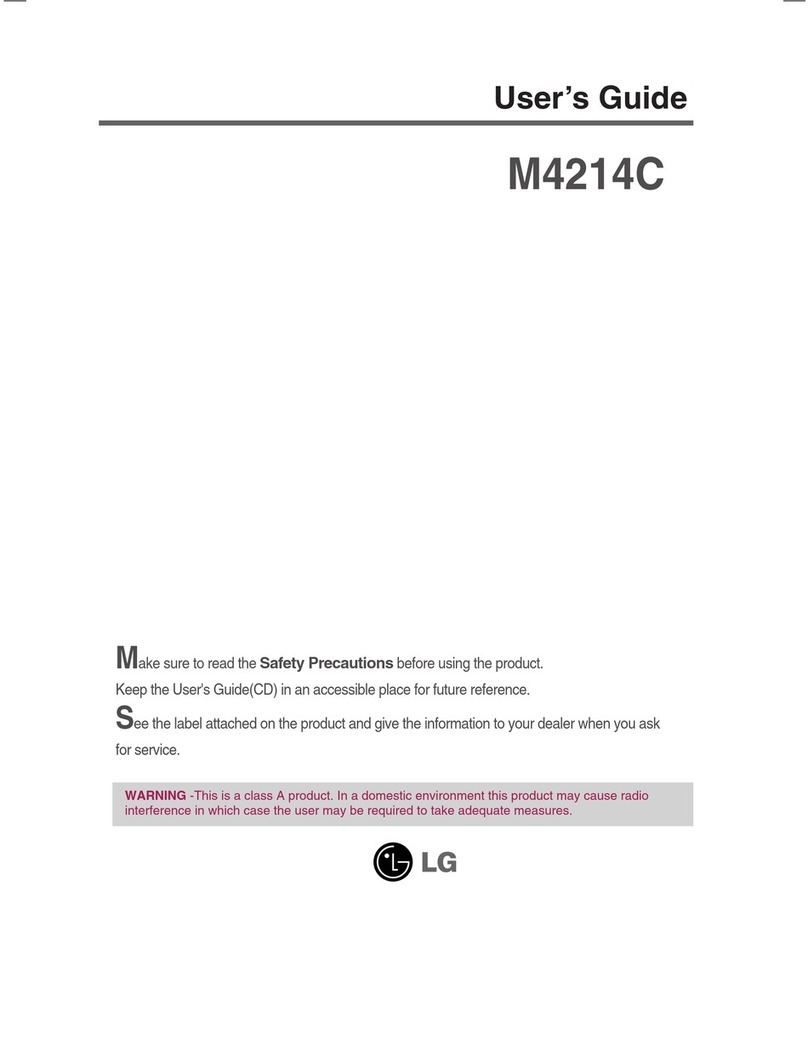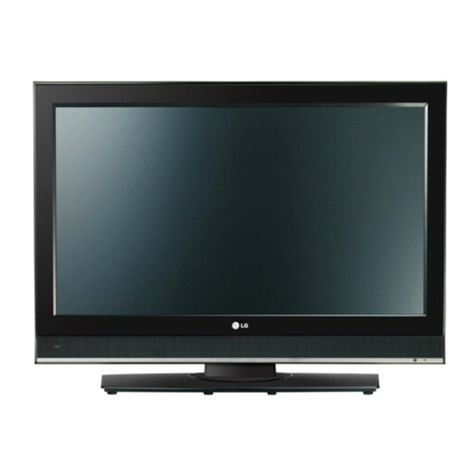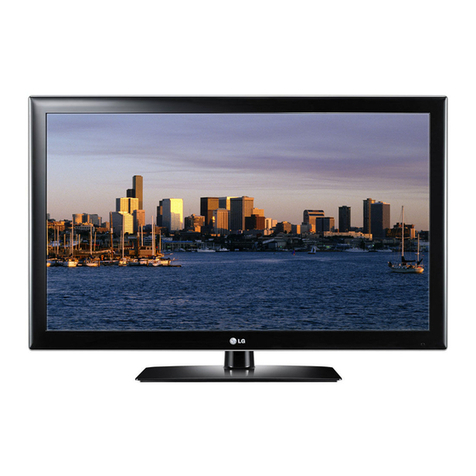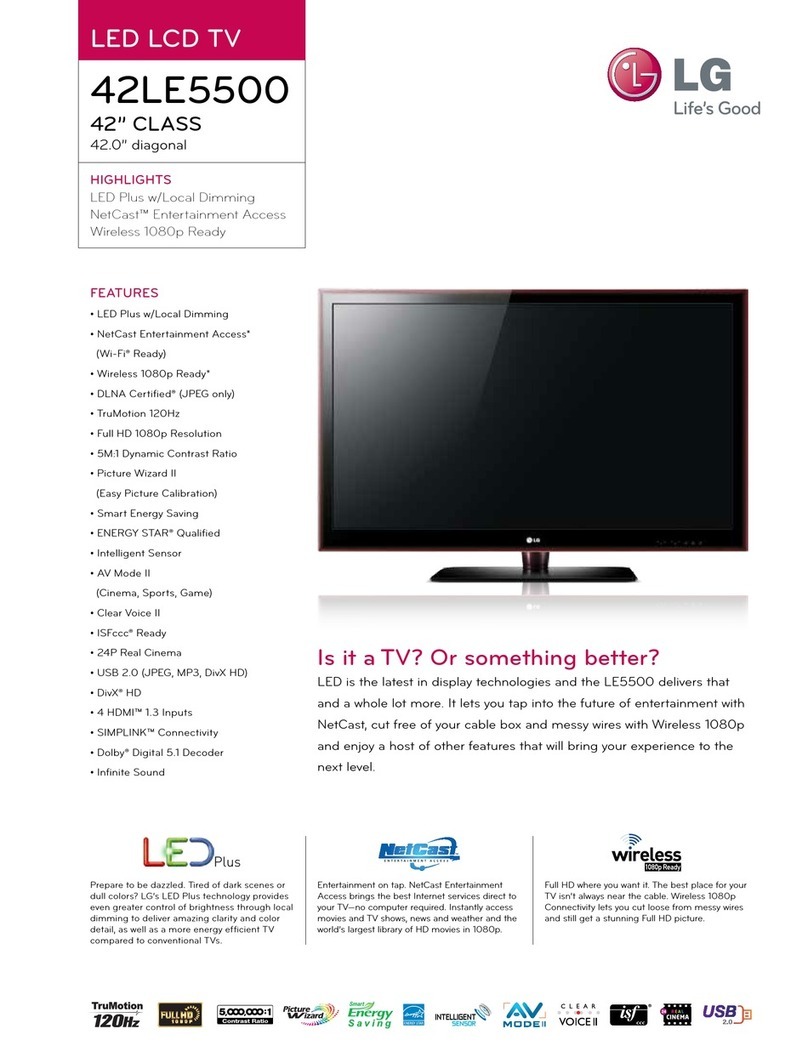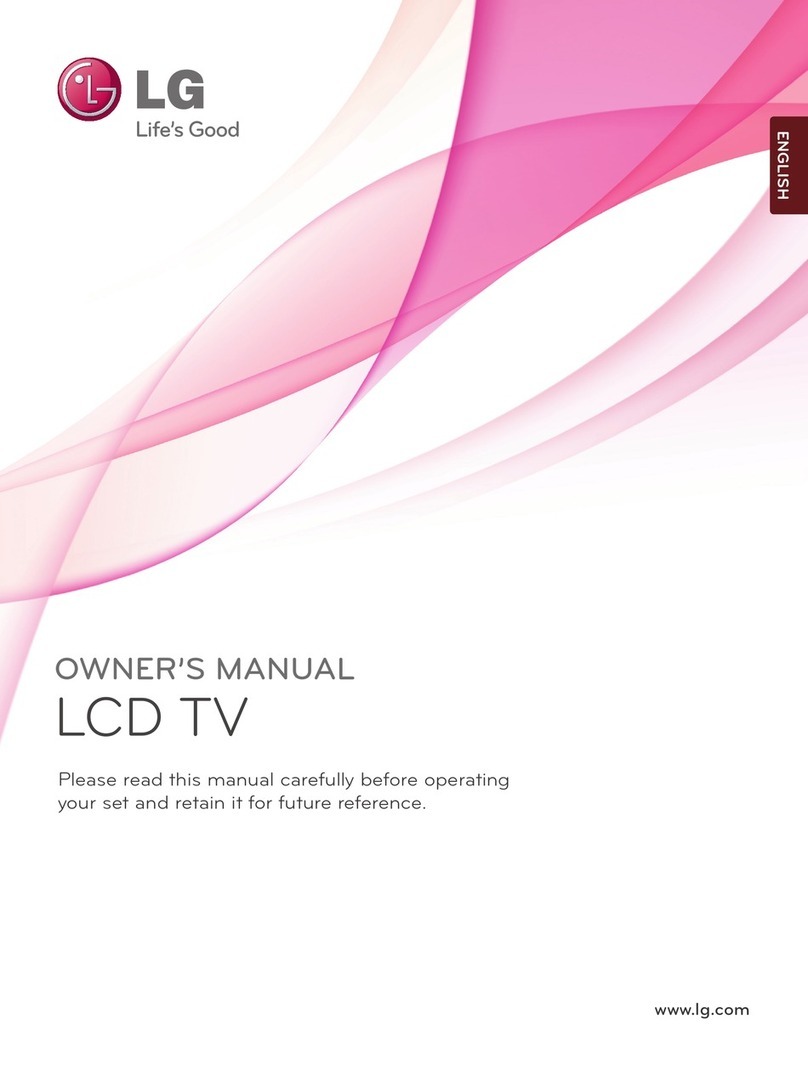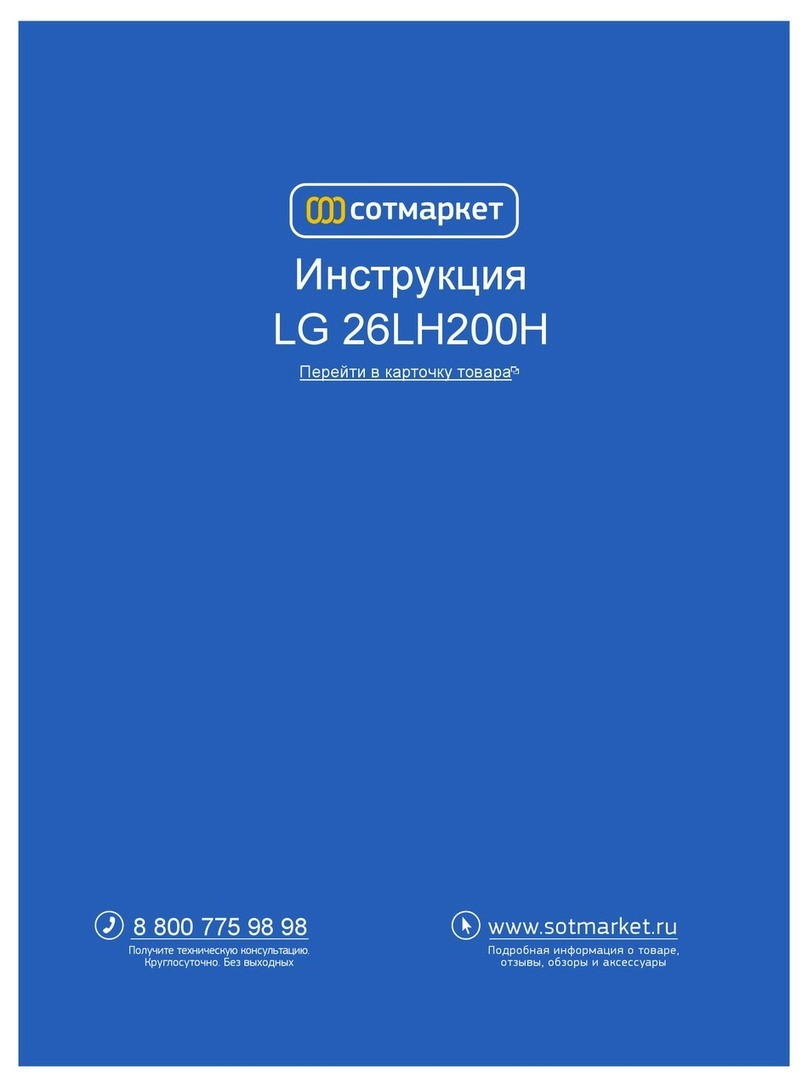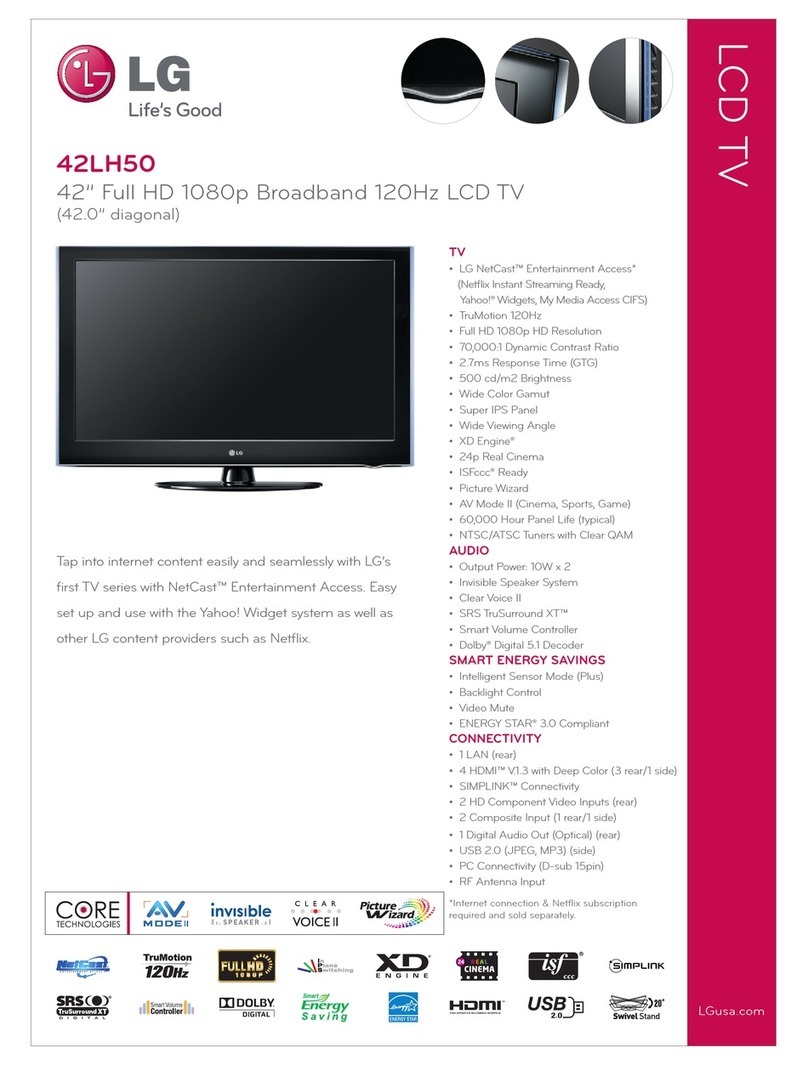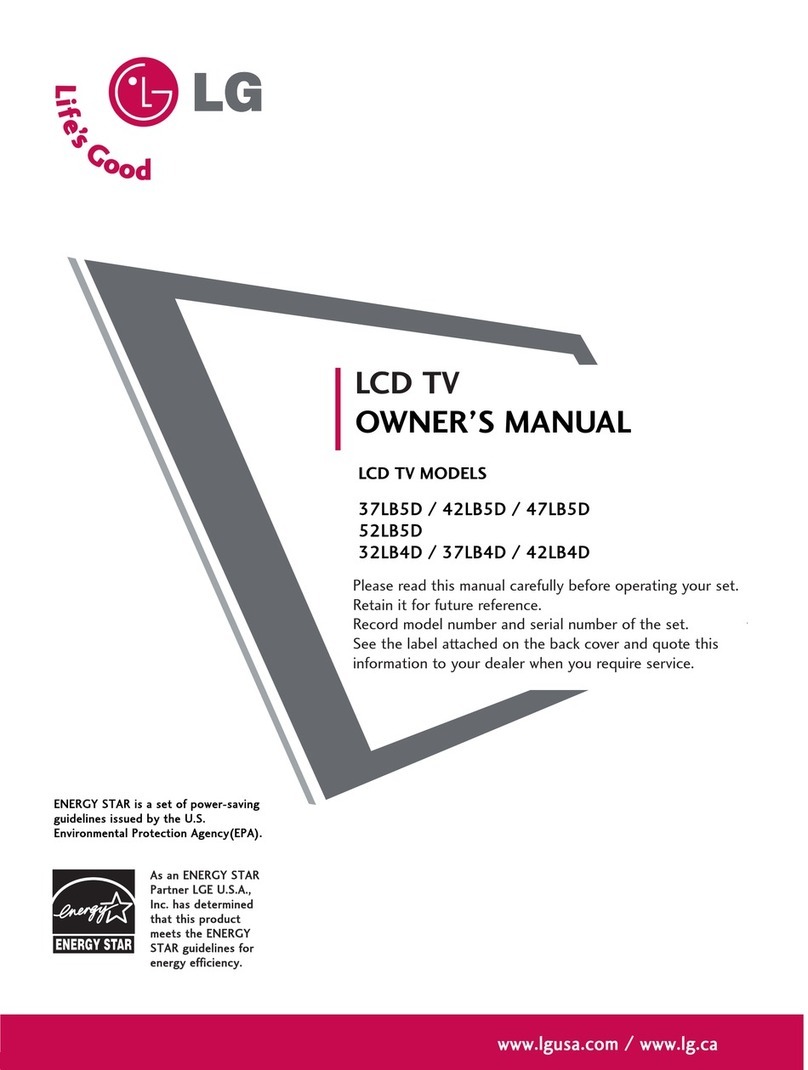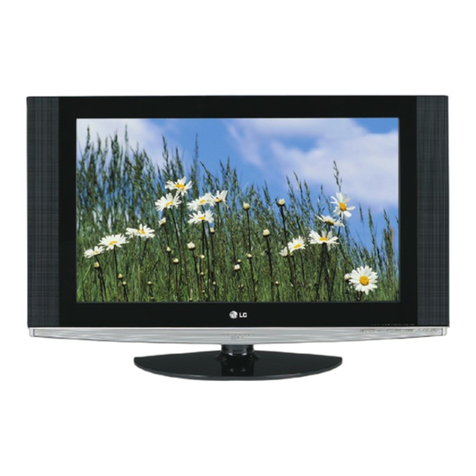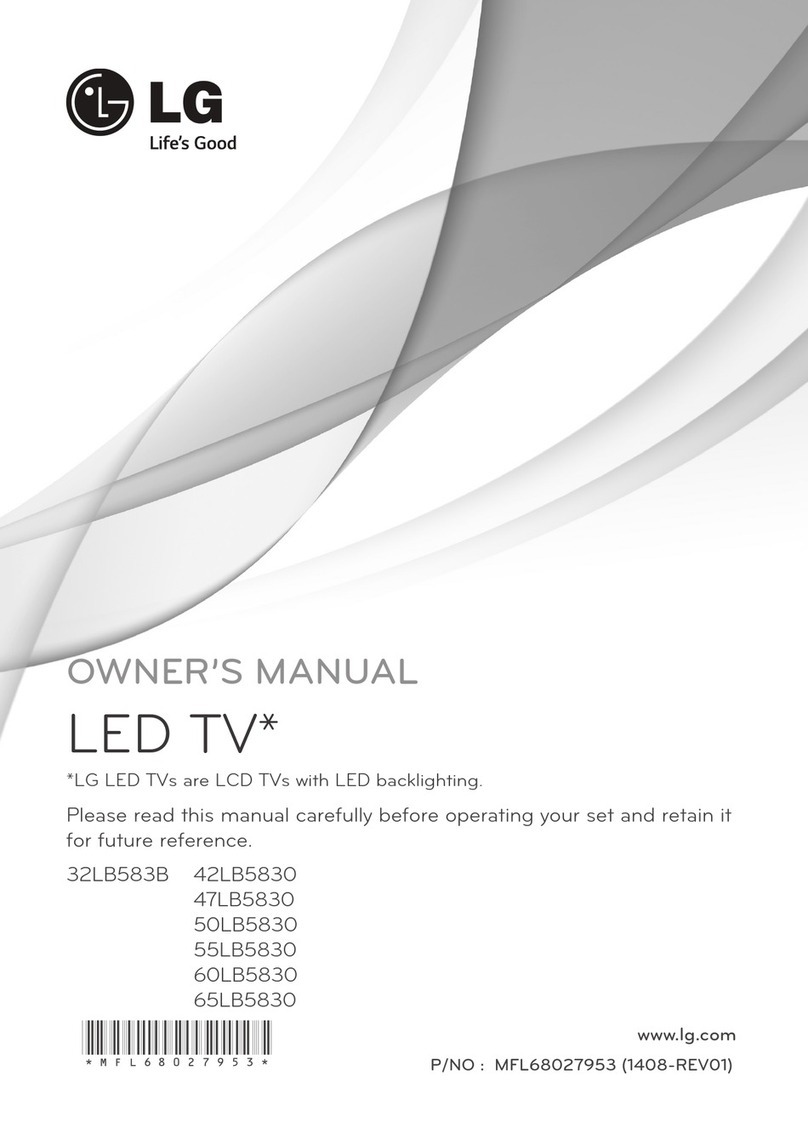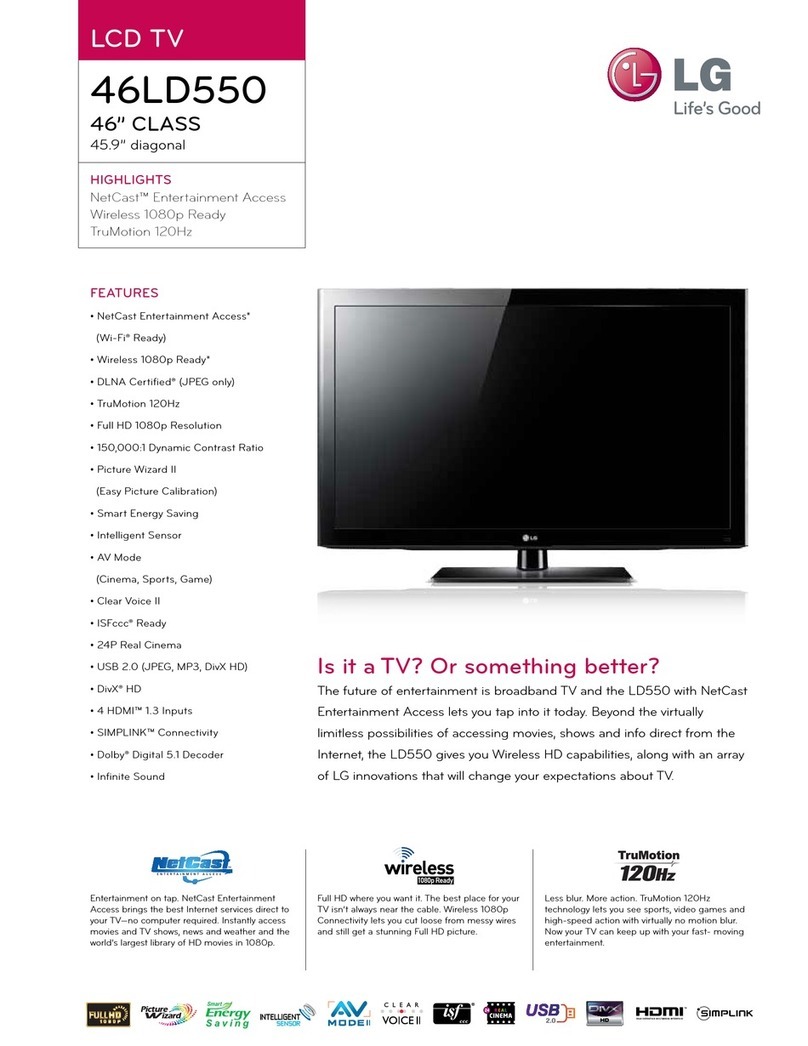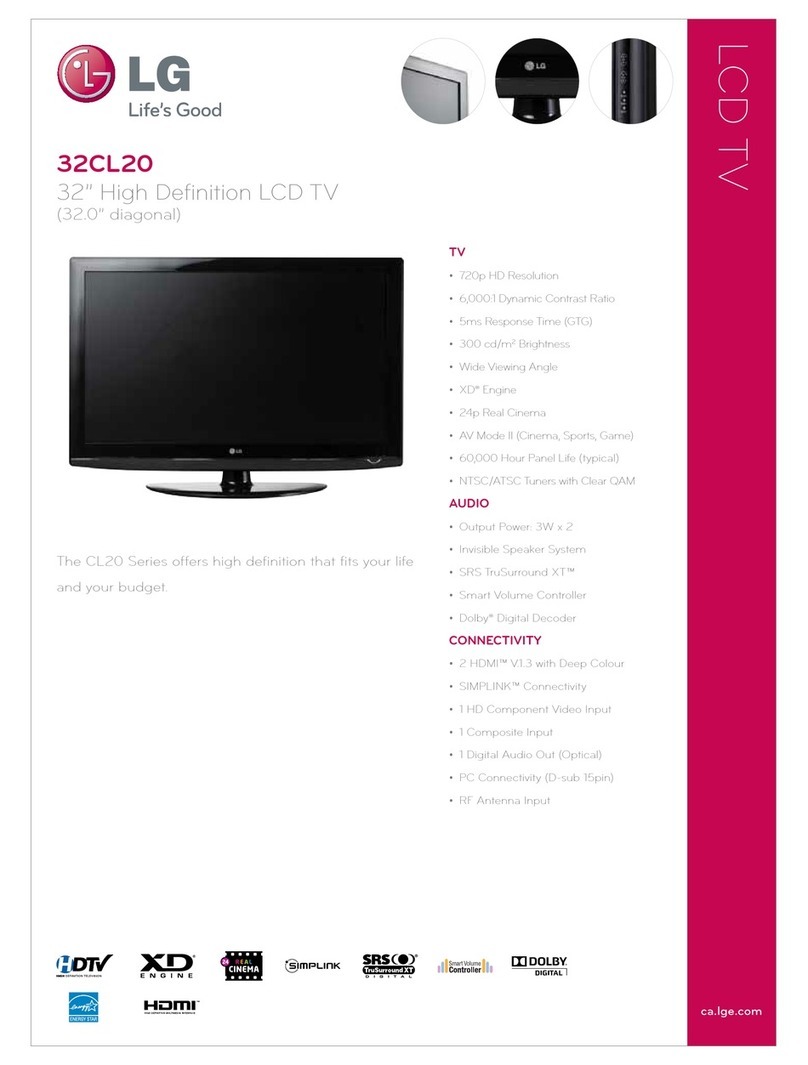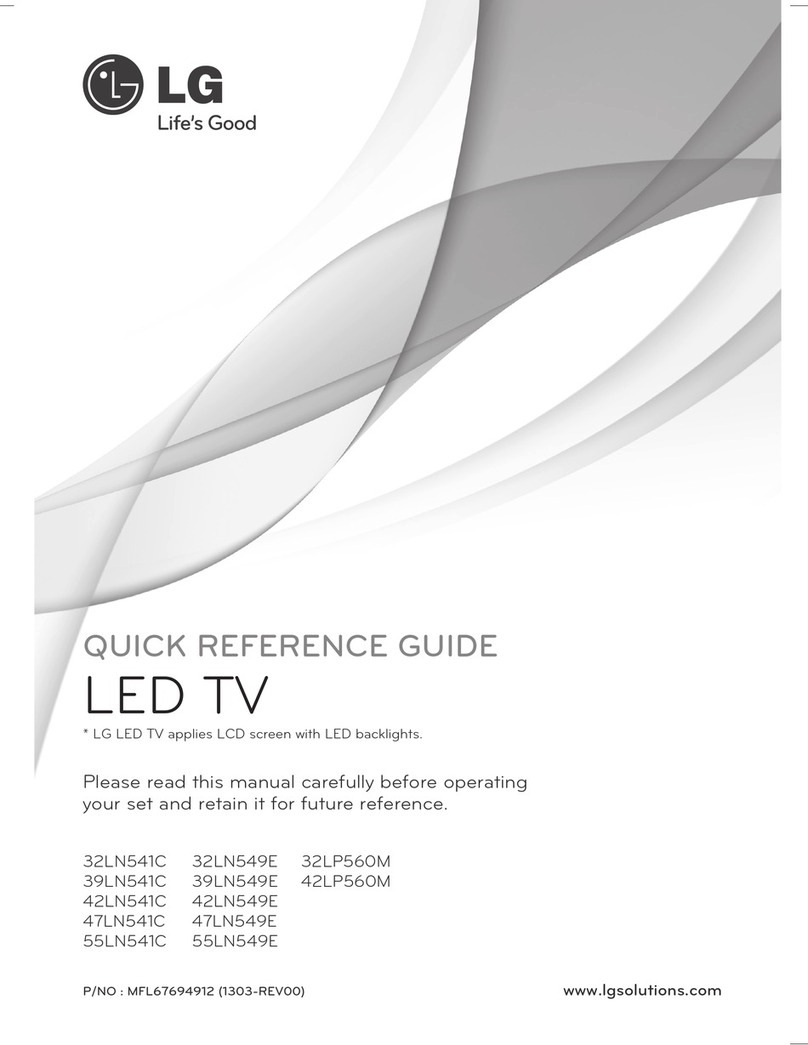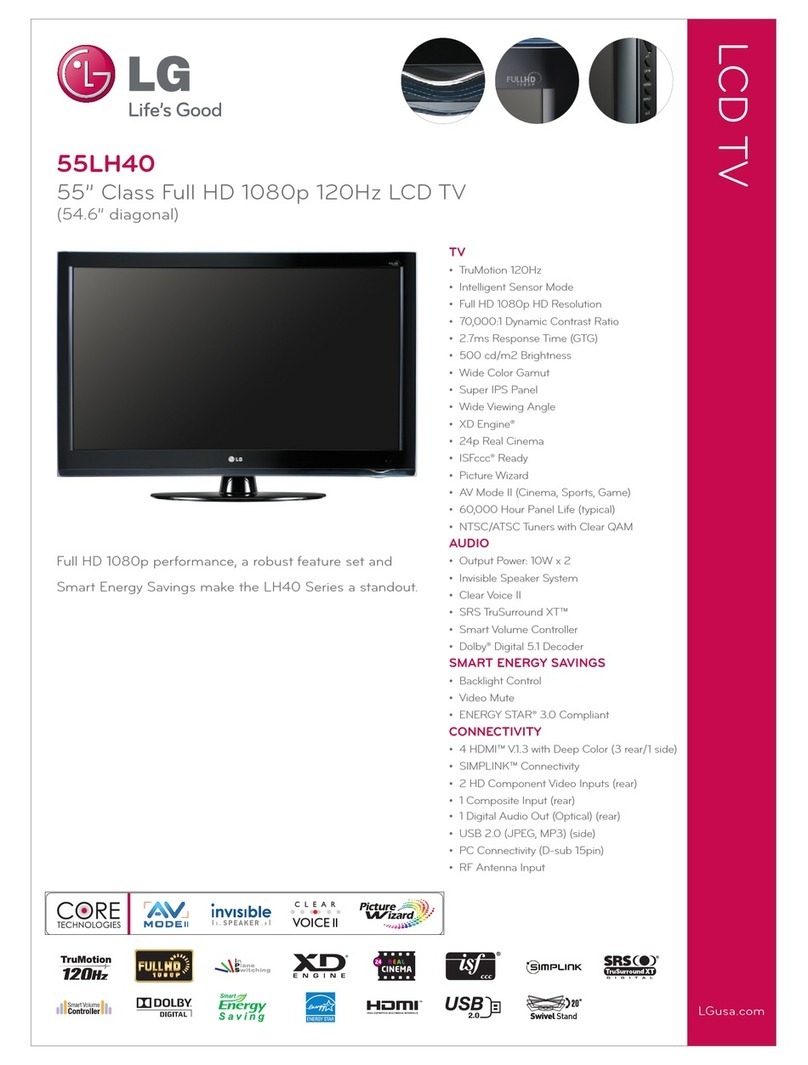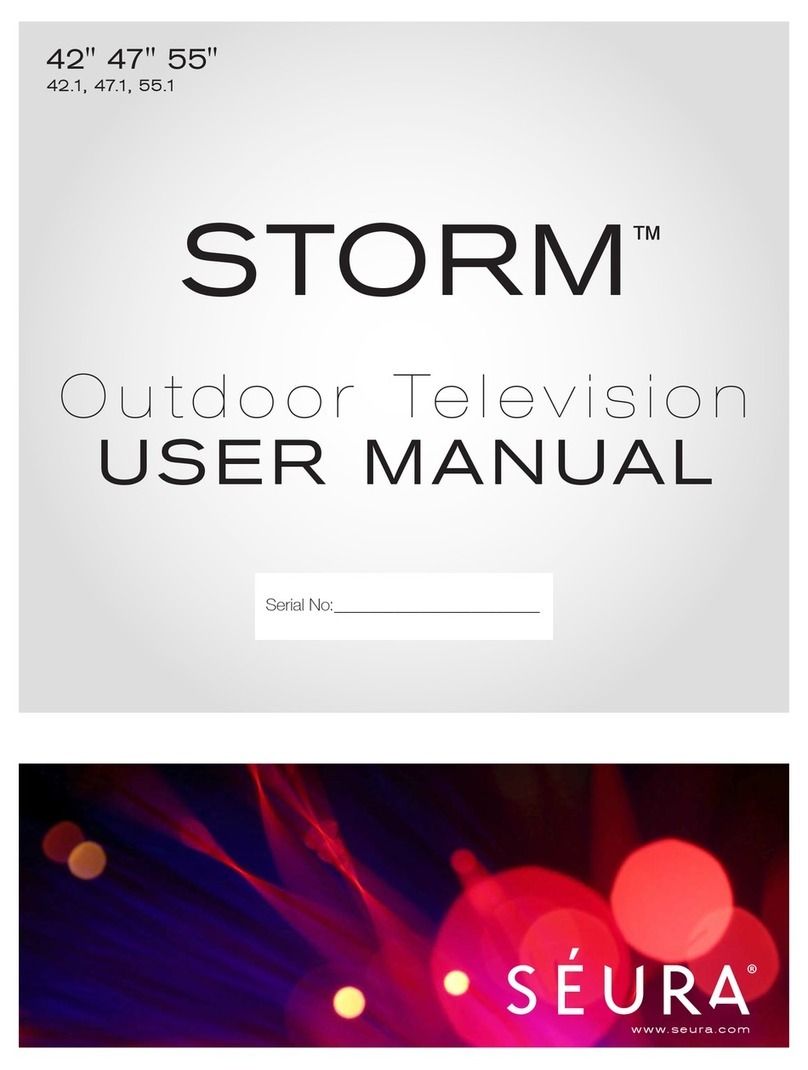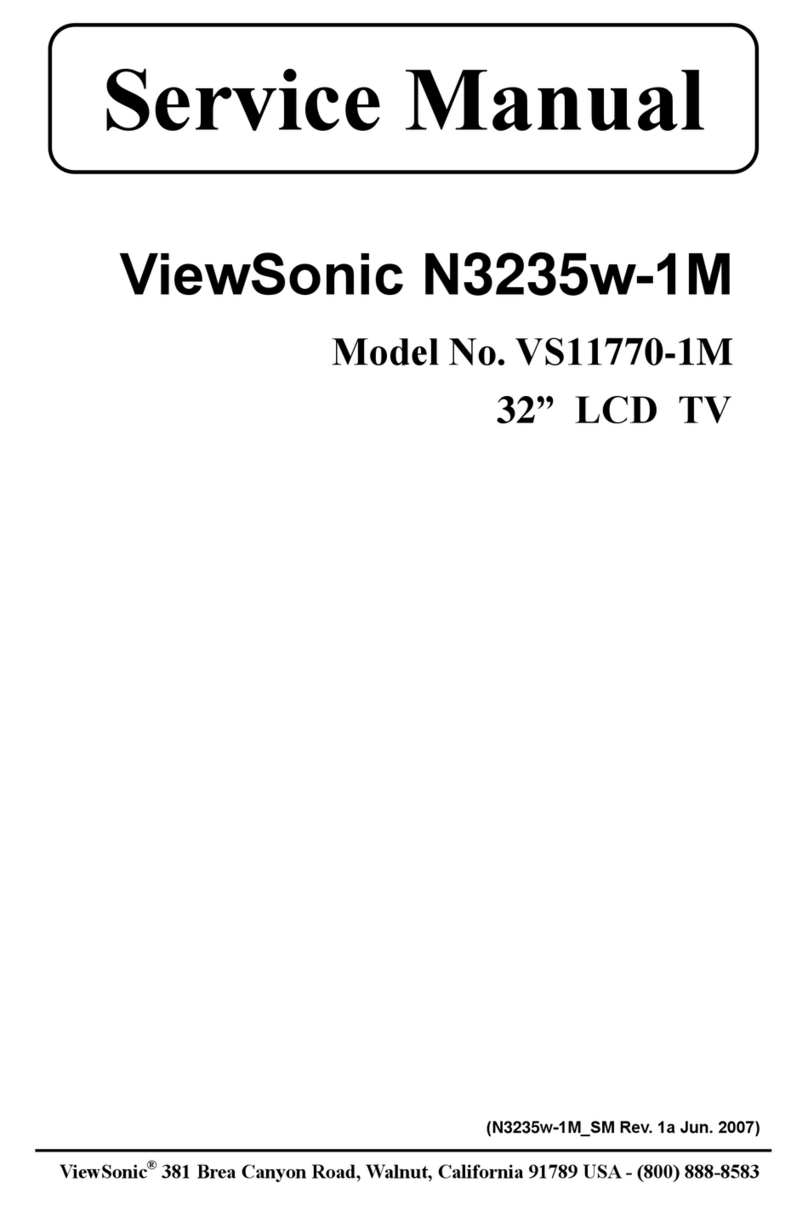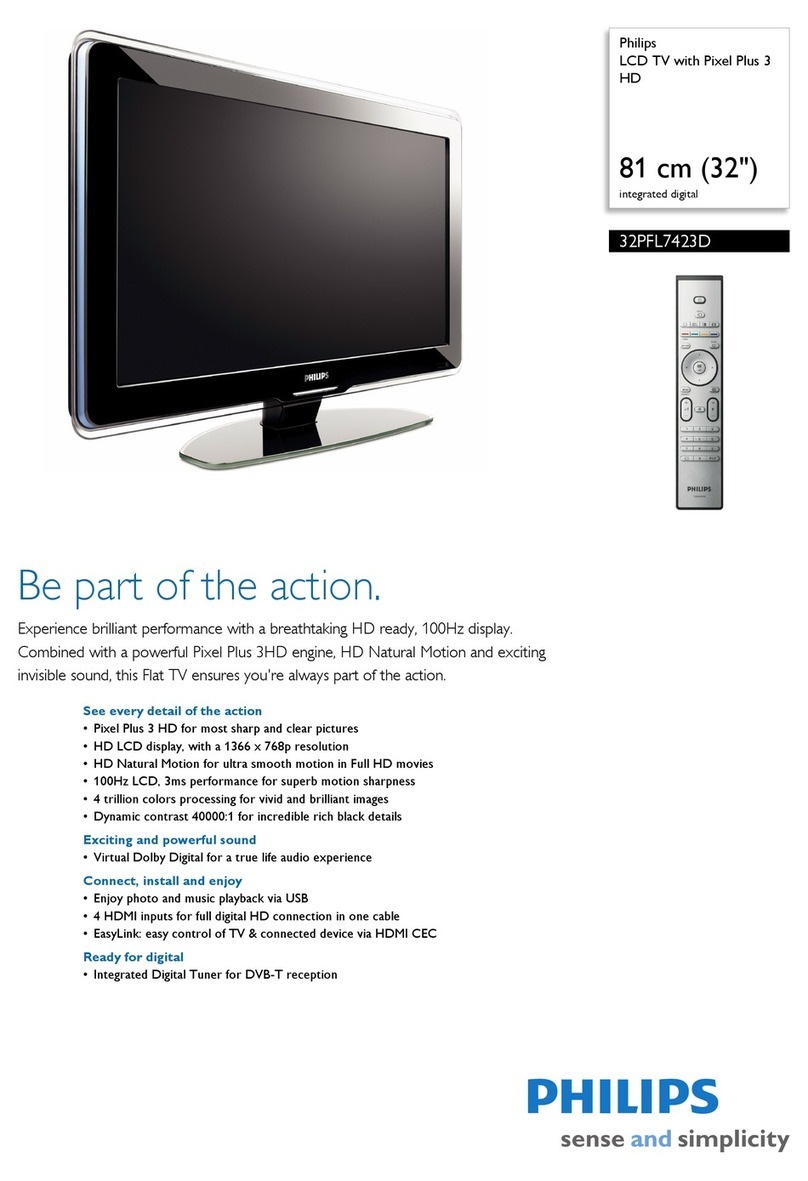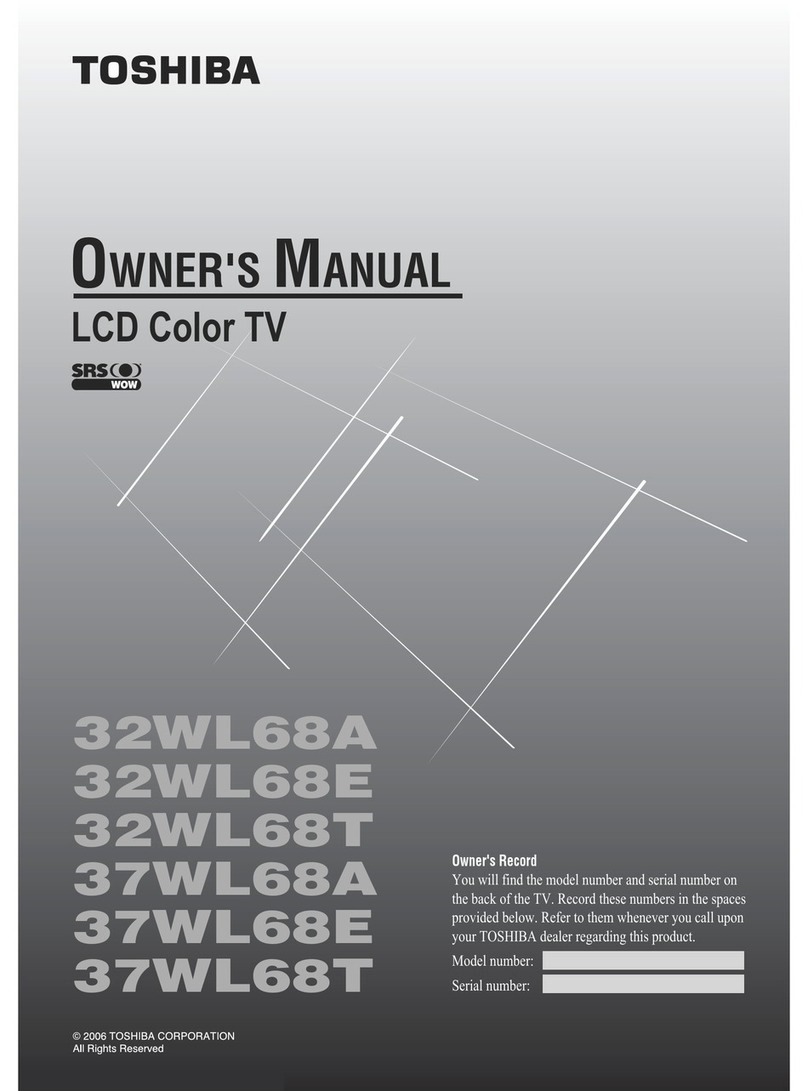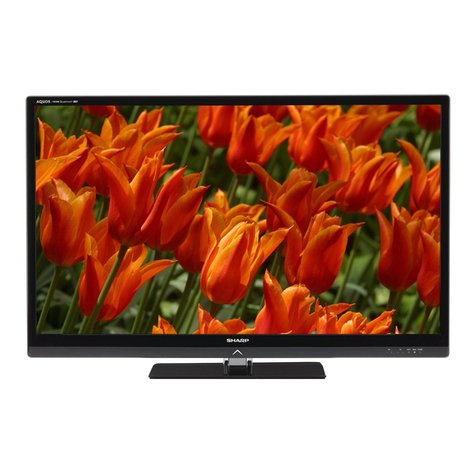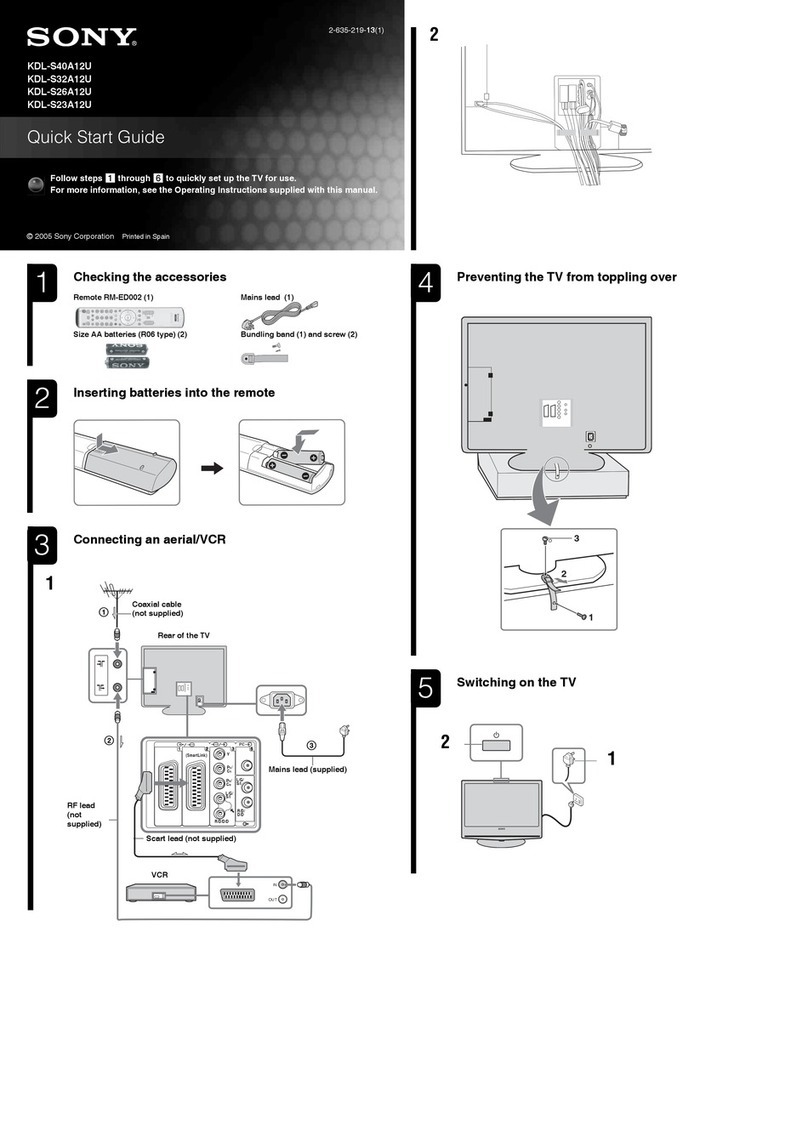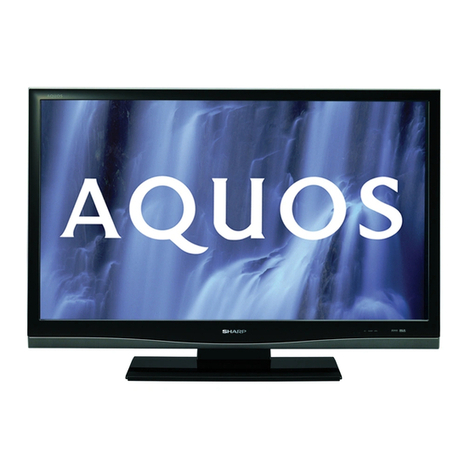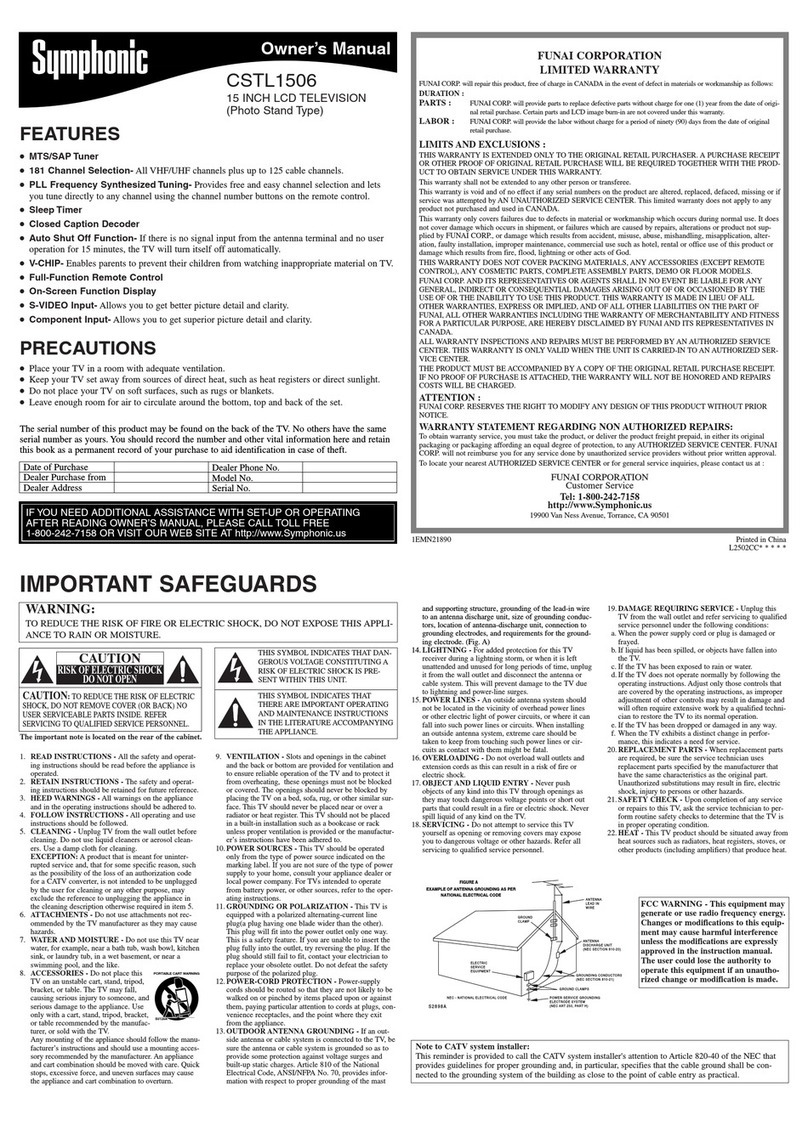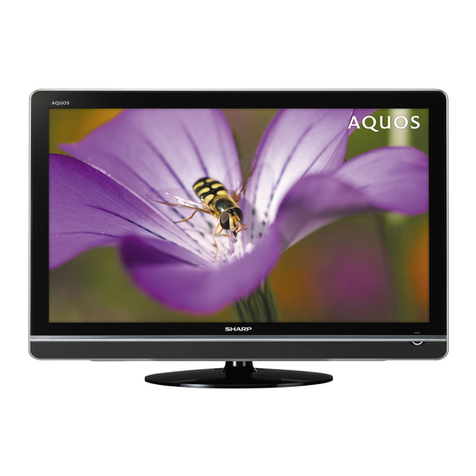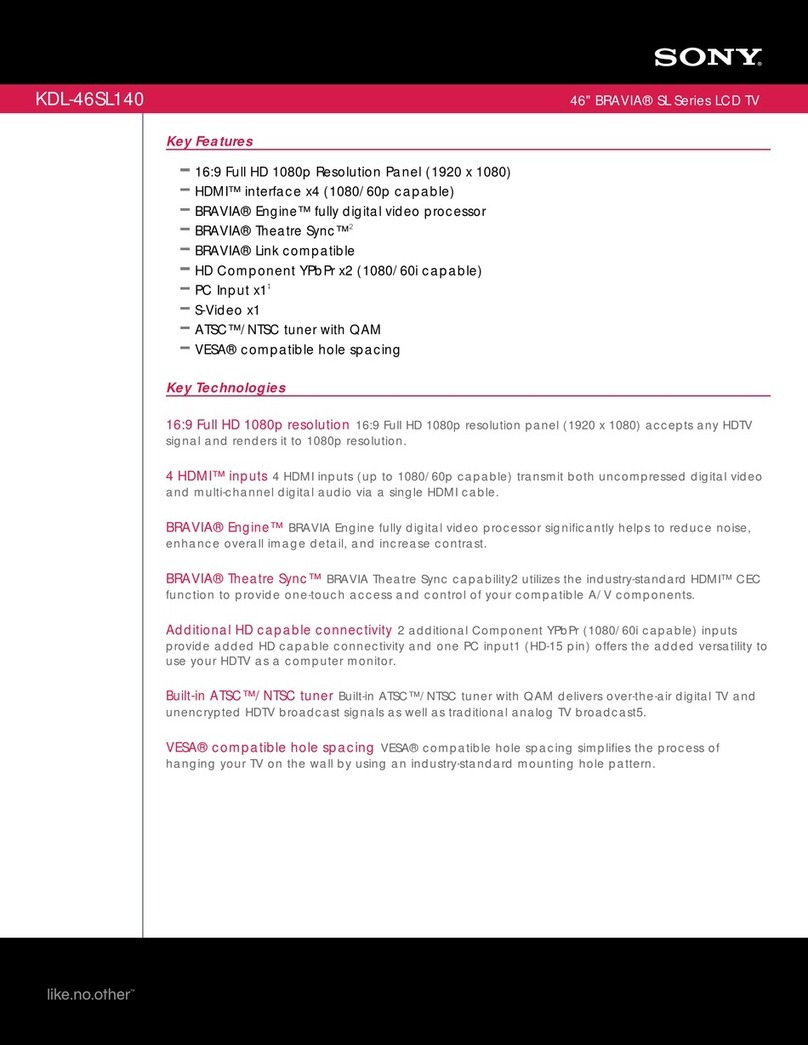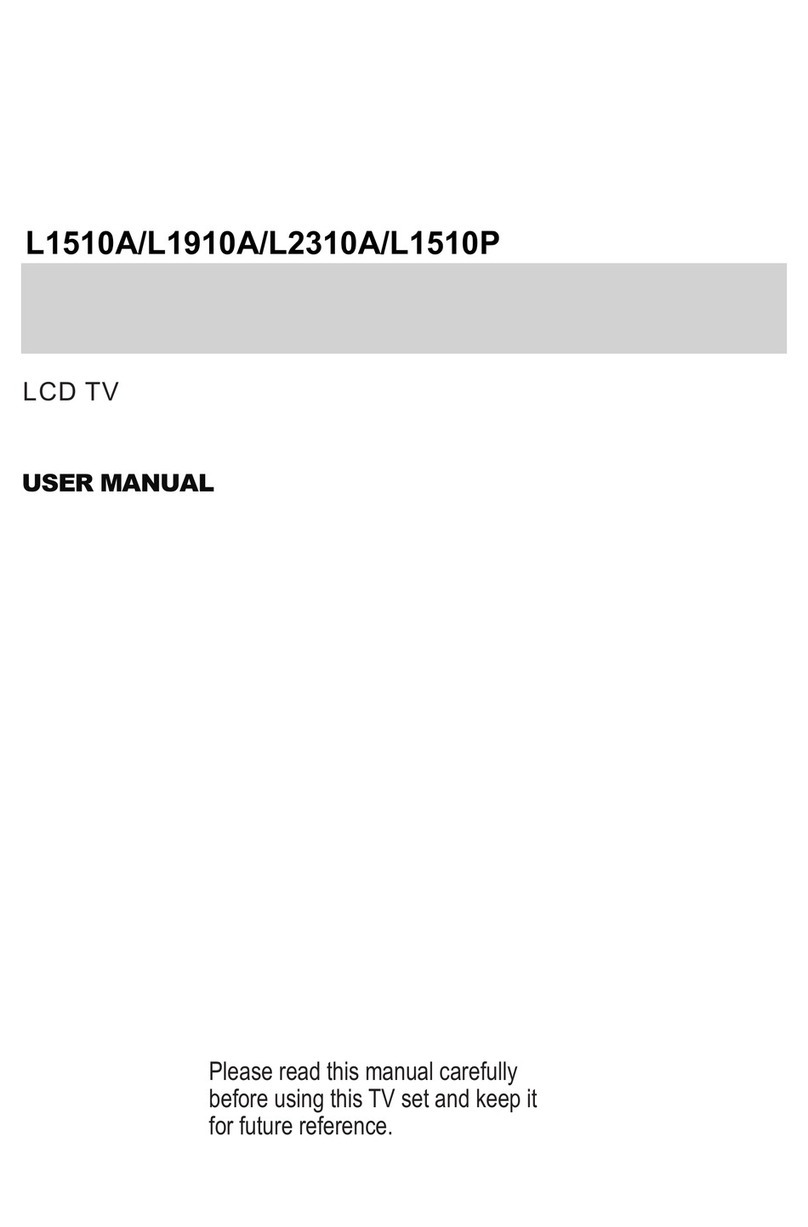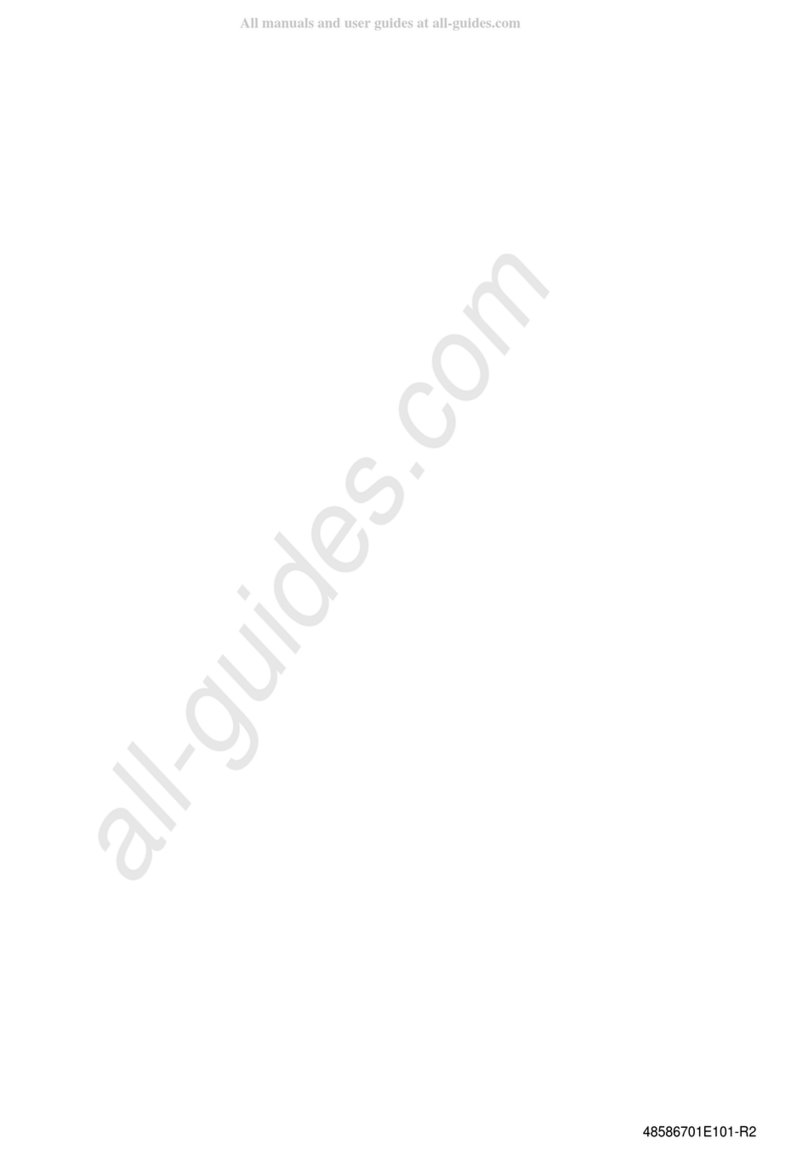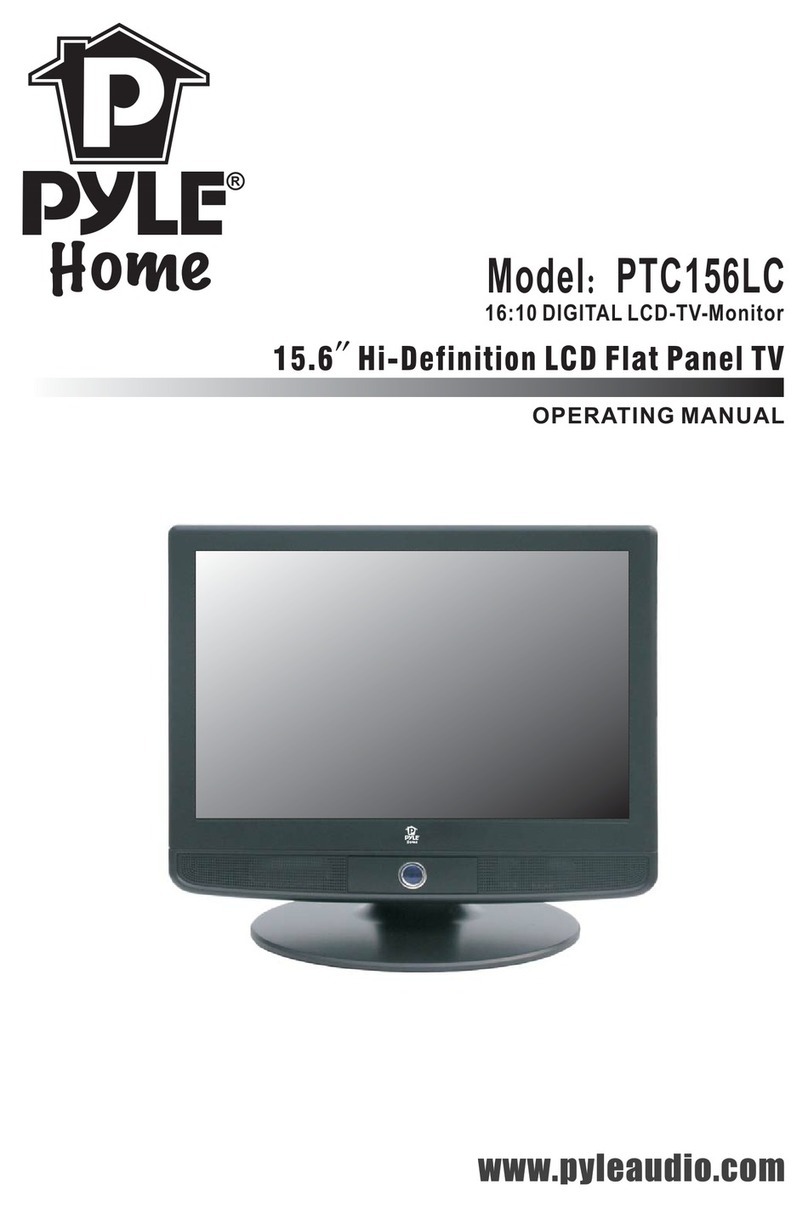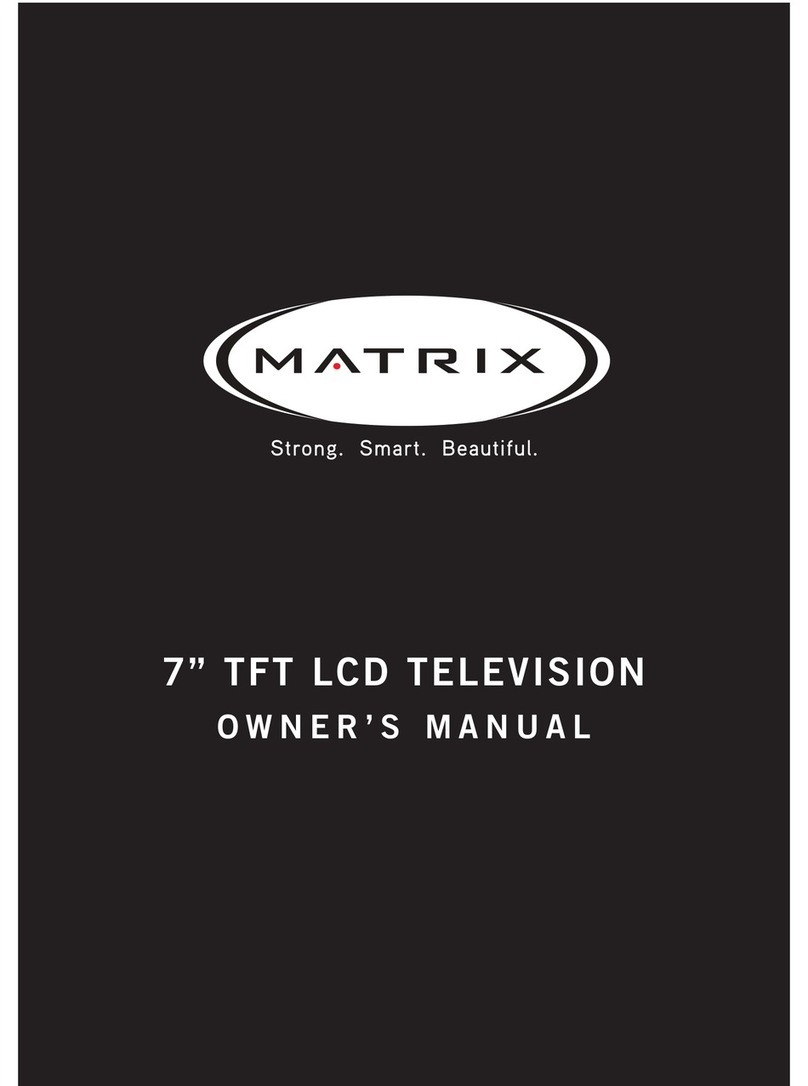LG 32LW5500 User manual

LCD TV
SERVICE MANUAL
CAUTION
BEFORE SERVICING THE CHASSIS,
READ THE SAFETY PRECAUTIONS IN THIS MANUAL.
CHASSIS : LC12C
MODEL : 32LW5500
42LW5500
47LW5500
32LW5500-CA
North/Latin America http://aic.lgservice.com
Europe/Africa http://eic.lgservice.com
Asia/Oceania http://biz.lgservice.com
Internal Use Only
Printed in ChinaP/NO : MFL67002332 (1109-REV00)
42LW5500-CA
47LW5500-CA

Copyright 2011 LG Electronics.Inc.All right reserved.
Only for training and service purposes
CLGE Internal Use Only- 1 -
CONTENTS
CONTENTS ..............................................................................................1
SAFETY PRECAUTIONS .........................................................................2
SPECIFICATION .......................................................................................5
ADJUSTMENT INSTRUCTION .............................................................. 8
EXPLODED VIEW ..................................................................................28
SVC. SHEET ...............................................................................................

Copyright 2011 LG Electronics.Inc.All right reserved.
Only for training and service purposes
CLGE Internal Use Only- 2 -
SAFETY PRECAUTIONS
Many electrical and mechanical parts in this chassis have special safety-related characteristics. These parts are identified by in the
Schematic Diagram and Exploded View.
It is essential that these special safety parts should be replaced with the same components as recommended in this manual to prevent
Shock, Fire, or other Hazards.
Do not modify the original design without permission of manufacturer.
General Guidance
An isolation Transformer should always be used during the
servicing of a receiver whose chassis is not isolated from the AC
power line. Use a transformer of adequate power rating as this
protects the technician from accidents resulting in personal injury
from electrical shocks.
It will also protect the receiver and it's components from being
damaged by accidental shorts of the circuitry that may be
inadvertently introduced during the service operation.
If any fuse (or Fusible Resistor) in this TV receiver is blown,
replace it with the specified.
When replacing a high wattage resistor (Oxide Metal Film Resistor,
over 1W), keep the resistor 10mm away from PCB.
Keep wires away from high voltage or high temperature parts.
Before returning the receiver to the customer,
always perform an AC leakage current check on the exposed
metallic parts of the cabinet, such as antennas, terminals, etc., to
be sure the set is safe to operate without damage of electrical
shock.
Leakage Current Cold Check(Antenna Cold Check)
With the instrument AC plug removed from AC source, connect an
electrical jumper across the two AC plug prongs. Place the AC
switch in the on position, connect one lead of ohm-meter to the AC
plug prongs tied together and touch other ohm-meter lead in turn to
each exposed metallic parts such as antenna terminals, phone
jacks, etc.
If the exposed metallic part has a return path to the chassis, the
measured resistance should be between 1MΩand 5.2MΩ.
When the exposed metal has no return path to the chassis the
reading must be infinite.
An other abnormality exists that must be corrected before the
receiver is returned to the customer.
Leakage Current Hot Check (See below Figure)
Plug the AC cord directly into the AC outlet.
Do not use a line Isolation Transformer during this check.
Connect 1.5K/10watt resistor in parallel with a 0.15uF capacitor
between a known good earth ground (Water Pipe, Conduit, etc.)
and the exposed metallic parts.
Measure the AC voltage across the resistor using AC voltmeter
with 1000 ohms/volt or more sensitivity.
Reverse plug the AC cord into the AC outlet and repeat AC voltage
measurements for each exposed metallic part. Any voltage
measured must not exceed 0.75 volt RMS which is corresponds to
0.5mA.
In case any measurement is out of the limits specified, there is
possibility of shock hazard and the set must be checked and
repaired before it is returned to the customer.
Leakage Current Hot Check circuit
1.5 Kohm/10W
To Instrument’s
exposed
METALLIC PARTS
Good Earth Ground
such as WATER PIPE,
CONDUIT etc.
AC Volt-meter
IMPORTANT SAFETY NOTICE
0.15uF

Copyright 2011 LG Electronics.Inc.All right reserved.
Only for training and service purposes
CLGE Internal Use Only- 3 -
CAUTION: Before servicing receivers covered by this service
manual and its supplements and addenda, read and follow the
SAFETY PRECAUTIONS on page 3 of this publication.
NOTE: If unforeseen circumstances create conflict between the
following servicing precautions and any of the safety precautions on
page 3 of this publication, always follow the safety precautions.
Remember: Safety First.
General Servicing Precautions
1. Always unplug the receiver AC power cord from the AC power
source before;
a. Removing or reinstalling any component, circuit board
module or any other receiver assembly.
b. Disconnecting or reconnecting any receiver electrical plug or
other electrical connection.
c. Connecting a test substitute in parallel with an electrolytic
capacitor in the receiver.
CAUTION: A wrong part substitution or incorrect polarity
installation of electrolytic capacitors may result in an
explosion hazard.
2. Test high voltage only by measuring it with an appropriate high
voltage meter or other voltage measuring device (DVM,
FETVOM, etc) equipped with a suitable high voltage probe.
Do not test high voltage by "drawing an arc".
3. Do not spray chemicals on or near this receiver or any of its
assemblies.
4. Unless specified otherwise in this service manual, clean
electrical contacts only by applying the following mixture to the
contacts with a pipe cleaner, cotton-tipped stick or comparable
non-abrasive applicator; 10% (by volume) Acetone and 90% (by
volume) isopropyl alcohol (90%-99% strength)
CAUTION: This is a flammable mixture.
Unless specified otherwise in this service manual, lubrication of
contacts in not required.
5. Do not defeat any plug/socket B+ voltage interlocks with which
receivers covered by this service manual might be equipped.
6. Do not apply AC power to this instrument and/or any of its
electrical assemblies unless all solid-state device heat sinks are
correctly installed.
7. Always connect the test receiver ground lead to the receiver
chassis ground before connecting the test receiver positive
lead.
Always remove the test receiver ground lead last.
8. Use with this receiver only the test fixtures specified in this
service manual.
CAUTION: Do not connect the test fixture ground strap to any
heat sink in this receiver.
Electrostatically Sensitive (ES) Devices
Some semiconductor (solid-state) devices can be damaged easily
by static electricity. Such components commonly are called
Electrostatically Sensitive (ES) Devices. Examples of typical ES
devices are integrated circuits and some field-effect transistors and
semiconductor "chip" components. The following techniques
should be used to help reduce the incidence of component
damage caused by static by static electricity.
1. Immediately before handling any semiconductor component or
semiconductor-equipped assembly, drain off any electrostatic
charge on your body by touching a known earth ground.
Alternatively, obtain and wear a commercially available
discharging wrist strap device, which should be removed to
prevent potential shock reasons prior to applying power to the
unit under test.
2. After removing an electrical assembly equipped with ES
devices, place the assembly on a conductive surface such as
aluminum foil, to prevent electrostatic charge buildup or
exposure of the assembly.
3. Use only a grounded-tip soldering iron to solder or unsolder ES
devices.
4. Use only an anti-static type solder removal device. Some solder
removal devices not classified as "anti-static" can generate
electrical charges sufficient to damage ES devices.
5. Do not use freon-propelled chemicals. These can generate
electrical charges sufficient to damage ES devices.
6. Do not remove a replacement ES device from its protective
package until immediately before you are ready to install it.
(Most replacement ES devices are packaged with leads
electrically shorted together by conductive foam, aluminum foil
or comparable conductive material).
7. Immediately before removing the protective material from the
leads of a replacement ES device, touch the protective material
to the chassis or circuit assembly into which the device will be
installed.
CAUTION: Be sure no power is applied to the chassis or circuit,
and observe all other safety precautions.
8. Minimize bodily motions when handling unpackaged
replacement ES devices. (Otherwise harmless motion such as
the brushing together of your clothes fabric or the lifting of your
foot from a carpeted floor can generate static electricity
sufficient to damage an ES device.)
General Soldering Guidelines
1. Use a grounded-tip, low-wattage soldering iron and appropriate
tip size and shape that will maintain tip temperature within the
range or 500°F to 600°F.
2. Use an appropriate gauge of RMA resin-core solder composed
of 60 parts tin/40 parts lead.
3. Keep the soldering iron tip clean and well tinned.
4. Thoroughly clean the surfaces to be soldered. Use a mall wire-
bristle (0.5 inch, or 1.25cm) brush with a metal handle.
Do not use freon-propelled spray-on cleaners.
5. Use the following unsoldering technique
a. Allow the soldering iron tip to reach normal temperature.
(500°F to 600°F)
b. Heat the component lead until the solder melts.
c. Quickly draw the melted solder with an anti-static, suction-
type solder removal device or with solder braid.
CAUTION: Work quickly to avoid overheating the circuit
board printed foil.
6. Use the following soldering technique.
a. Allow the soldering iron tip to reach a normal temperature
(500°F to 600°F)
b. First, hold the soldering iron tip and solder the strand against
the component lead until the solder melts.
c. Quickly move the soldering iron tip to the junction of the
component lead and the printed circuit foil, and hold it there
only until the solder flows onto and around both the
component lead and the foil.
CAUTION: Work quickly to avoid overheating the circuit
board printed foil.
d. Closely inspect the solder area and remove any excess or
splashed solder with a small wire-bristle brush.
SERVICING PRECAUTIONS

Copyright 2011 LG Electronics.Inc.All right reserved.
Only for training and service purposes
CLGE Internal Use Only- 4 -
IC Remove/Replacement
Some chassis circuit boards have slotted holes (oblong) through
which the IC leads are inserted and then bent flat against the
circuit foil. When holes are the slotted type, the following technique
should be used to remove and replace the IC. When working with
boards using the familiar round hole, use the standard technique
as outlined in paragraphs 5 and 6 above.
Removal
1. Desolder and straighten each IC lead in one operation by gently
prying up on the lead with the soldering iron tip as the solder
melts.
2. Draw away the melted solder with an anti-static suction-type
solder removal device (or with solder braid) before removing the
IC.
Replacement
1. Carefully insert the replacement IC in the circuit board.
2. Carefully bend each IC lead against the circuit foil pad and
solder it.
3. Clean the soldered areas with a small wire-bristle brush.
(It is not necessary to reapply acrylic coating to the areas).
"Small-Signal" Discrete Transistor
Removal/Replacement
1. Remove the defective transistor by clipping its leads as close as
possible to the component body.
2. Bend into a "U" shape the end of each of three leads remaining
on the circuit board.
3. Bend into a "U" shape the replacement transistor leads.
4. Connect the replacement transistor leads to the corresponding
leads extending from the circuit board and crimp the "U" with
long nose pliers to insure metal to metal contact then solder
each connection.
Power Output, Transistor Device
Removal/Replacement
1. Heat and remove all solder from around the transistor leads.
2. Remove the heat sink mounting screw (if so equipped).
3. Carefully remove the transistor from the heat sink of the circuit
board.
4. Insert new transistor in the circuit board.
5. Solder each transistor lead, and clip off excess lead.
6. Replace heat sink.
Diode Removal/Replacement
1. Remove defective diode by clipping its leads as close as
possible to diode body.
2. Bend the two remaining leads perpendicular y to the circuit
board.
3. Observing diode polarity, wrap each lead of the new diode
around the corresponding lead on the circuit board.
4. Securely crimp each connection and solder it.
5. Inspect (on the circuit board copper side) the solder joints of
the two "original" leads. If they are not shiny, reheat them and if
necessary, apply additional solder.
Fuse and Conventional Resistor
Removal/Replacement
1. Clip each fuse or resistor lead at top of the circuit board hollow
stake.
2. Securely crimp the leads of replacement component around
notch at stake top.
3. Solder the connections.
CAUTION: Maintain original spacing between the replaced
component and adjacent components and the circuit board to
prevent excessive component temperatures.
Circuit Board Foil Repair
Excessive heat applied to the copper foil of any printed circuit
board will weaken the adhesive that bonds the foil to the circuit
board causing the foil to separate from or "lift-off" the board. The
following guidelines and procedures should be followed whenever
this condition is encountered.
At IC Connections
To repair a defective copper pattern at IC connections use the
following procedure to install a jumper wire on the copper pattern
side of the circuit board. (Use this technique only on IC
connections).
1. Carefully remove the damaged copper pattern with a sharp
knife. (Remove only as much copper as absolutely necessary).
2. carefully scratch away the solder resist and acrylic coating (if
used) from the end of the remaining copper pattern.
3. Bend a small "U" in one end of a small gauge jumper wire and
carefully crimp it around the IC pin. Solder the IC connection.
4. Route the jumper wire along the path of the out-away copper
pattern and let it overlap the previously scraped end of the good
copper pattern. Solder the overlapped area and clip off any
excess jumper wire.
At Other Connections
Use the following technique to repair the defective copper pattern
at connections other than IC Pins. This technique involves the
installation of a jumper wire on the component side of the circuit
board.
1. Remove the defective copper pattern with a sharp knife.
Remove at least 1/4 inch of copper, to ensure that a hazardous
condition will not exist if the jumper wire opens.
2. Trace along the copper pattern from both sides of the pattern
break and locate the nearest component that is directly
connected to the affected copper pattern.
3. Connect insulated 20-gauge jumper wire from the lead of the
nearest component on one side of the pattern break to the lead
of the nearest component on the other side.
Carefully crimp and solder the connections.
CAUTION: Be sure the insulated jumper wire is dressed so the
it does not touch components or sharp edges.

Copyright 2011 LG Electronics.Inc.All right reserved.
Only for training and service purposes
CLGE Internal Use Only- 5 -
1. Application range
This specification is applied to the LCD TV used LC12C chassis.
2. Requirement for Test
Each part is tested as below without special appointment.
1) Temperature: 25 ºC ± 5 ºC(77 ºF ± 9 ºF), CST: 40 ºC ± 5 ºC
2) Relative Humidity : 65 % ± 10 %
3) Power Voltage: Standard input voltage (AC 100-240 V~ 50 / 60 Hz)
* Standard Voltage of each products is marked by models.
4) Specification and performance of each parts are followed each drawing and specification by part number in accordance with
BOM.
5) The receiver must be operated for about 5 minutes prior to the adjustment.
3. Test method
1) Performance: LGE TV test method followed
2) Demanded other specification
- Safety : CE, IEC specification
- EMC :CE, IEC
4. Module General Specification
SPECIFICATION
NOTE : Specifications and others are subject to change without notice for improvement
.
No. Item Specification Remark
1 Display Screen Device 32,42,47Wide Color Display Module
2 Aspect Ratio 16:9
3 LCD Module LC320EUF-SDF3
4 Operating Environment Temp. : 0 deg ~ 50 deg
Humidity : 20 % ~ 90 %
5 Storage Environment Temp. : -20 deg ~ 60 deg
Humidity : 10 ~ 90 %
6 Input Voltage AC 100-240V~, 50 / 60Hz
7 Power Consumption Power on (White)
32LGD Typ : 69.7W
8 Outline Dimension 698.40(H) x 392.85 (V) x 10.8(B) / 24.0 mm (D)
8 Pixel Pitch 0.36375 mm x 0.36375 mm x RGB
9 Back Light Edge LED
10 Color depth 10Bit(D), 1.06 Billion colors
11 Surface treatment Hard coating(2H), Anti-glare treatment of the front
polarizer (Haze 10%)
32LW5500-CA
LCD
LC420EUF-SDF1/ LC420EUF-SDF2
LC470EUF-SDF1/ LC470EUF-SDF2
42LW5500-CA
47LW5500-CA
42LGD Typ : 90.5W
47LGD Typ : 90W
1078.6(H) x 626.0(V) x 10.8(B) / 22.9mm (D)
968.4(H) x 564.0(V) x 10.8(B) / 22.9mm(D)
32LGD
42LGD
47LGD
32LGD
42LGD
47LGD
0.4845 mm x 0.4845 mm x RGB
0.5415 mm x 0.5415 mm x RGB

Copyright 2011 LG Electronics.Inc.All right reserved.
Only for training and service purposes
CLGE Internal Use Only- 6 -
No. Specification Remark
Resolution H-freq(kHz) V-freq(Hz)
1. 720x480 15.73 60.00 SDTV,DVD 480i
2. 720x480 15.63 59.94 SDTV,DVD 480i
3. 720x480 31.47 59.94 480p
4. 720x480 31.50 60.00 480p
5. 720x576 15.625 50.00 SDTV,DVD 625 Line
6. 720x576 31.25 50.00 HDTV 576p
7. 1280x720 45.00 50.00 HDTV 720p
8. 1280x720 44.96 59.94 HDTV 720p
9. 1280x720 45.00 60.00 HDTV 720p
10. 1920x1080 31.25 50.00 HDTV 1080i
11. 1920x1080 33.75 60.00 HDTV 1080i
12. 1920x1080 33.72 59.94 HDTV 1080i
13. 1920x1080 56.250 50 HDTV 1080p
14. 1920x1080 67.5 60 HDTV 1080p
No. Specification Proposed Remarks
Resolution H-freq(kHz) V-freq(Hz) Pixel Clock(MHz)
1. 720*400 31.468 70.08 28.321 For only DOS mode
2. 640*480 31.469 59.94 25.17 VESA
Input 848*480
60 Hz, 852*480 60 Hz
-> 640*480 60 Hz Display
3. 800*600 37.879 60.31 40.00 VESA
4. 1024*768 48.363 60.00 65.00 VESA(XGA)
5. 1280*768 47.78 59.87 79.5 WXGA
6. 1360*768 47.72 59.8 84.75 WXGA
7. 1920*1080 66.587 59.93 138.625 WUXGA FHD model
6. RGB (PC)
5. Component Video Input (Y, CB/PB, CR/PR)

Copyright 2011 LG Electronics.Inc.All right reserved.
Only for training and service purposes
CLGE Internal Use Only- 7 -
No. Resolution H-freq(kHz) V-freq.(Hz) Pixel clock(MHz) Proposed Remark
1. 720*400 31.468 70.08 28.321 HDCP
2. 640*480 31.469 59.94 25.17 VESA HDCP
3. 800*600 37.879 60.31 40.00 VESA HDCP
4. 1024*768 48.363 60.00 65.00 VESA(XGA) HDCP
5. 1280*768 47.78 59.87 79.5 WXGA HDCP
6. 1360*768 47.72 59.8 84.75 WXGA HDCP
7. 1280*1024 63.595 60.0 108.875 SXGA HDCP/FHD model
8. 1920*1080 67.5 60.00 138.625 WUXGA HDCP/FHD model
(2) PC Mode
No. Resolution H-freq(kHz) V-freq.(Hz) Pixel clock(MHz) Proposed Remark
1. 720*480 31.469 /31.5 59.94 /60 27.00/27.03 SDTV 480P
2. 720*576 31.25 50 54 SDTV 576P
3. 1280*720 37.500 50 74.25 HDTV 720P
4. 1280*720 44.96 /45 59.94 /60 74.17/74.25 HDTV 720P
5. 1920*1080 33.72 /33.75 59.94 /60 74.17/74.25 HDTV 1080I
6. 1920*1080 28.125 50.00 74.25 HDTV 1080I
7. 1920*1080 26.97 /27 23.97 /24 74.17/74.25 HDTV 1080P
8. 1920*1080 33.716 /33.75 29.976 /30.00 74.25 HDTV 1080P
9. 1920*1080 56.250 50 148.5 HDTV 1080P
10. 1920*1080 67.43 /67.5 59.94 /60 148.35/148.50 HDTV 1080P
7. HDMI Input
(1) DTV Mode

Copyright 2011 LG Electronics.Inc.All right reserved.
Only for training and service purposes
CLGE Internal Use Only- 8 -
ADJUSTMENT INSTRUCTION
1. Application range
Chassis Model Name Module
type
Local
dimming Remark
Edge LEDO 1 point W/B adjustment
LC12C 32/42/47LW5500-CA
1.1 This spec sheet is applied all of the LCD TV with LC12C chassis.
1.2 Main manufacturing type
▪SET ( o )
▪CKD ( o )
▪SKD ( o )
2. Specification
2.1 Because this is not a hot chassis, it is not necessary to use an isolation transformer.
However, the use of isolation transformer will help protect test instrument.
2.2 Adjustment must be done in the correct order.
2.3 The adjustment must be performed in the circumstance of 25 ±5 °C of temperature and
65±10% of relative humidity if there is no specific designation.
2.4 The input voltage of the receiver must keep 100~240V, 50/60Hz.
2.5 At first worker must turn on the SET by using Power Only Key.
2.6 The receiver must be operated for about 5 minutes prior to the adjustment when module
is in the circumstance of over 15
In case of keeping module is in the circumstance of 0°C, it should be placed in the
circumstance of above 15°C for 2 hours
In case of keeping module is in the circumstance of below -20°C, it should be
placed in the circumstance of above 15°C for 3 hours,.
Caution) When still image is displayed for a period of 20 minutes or longer (especially where
W/B scale is strong. Digital pattern 13ch and/or Cross hatch pattern 09ch), there can some
afterimage in the black level area.

Copyright 2011 LG Electronics.Inc.All right reserved.
Only for training and service purposes
CLGE Internal Use Only- 9 -
3. Adjustment items
3.1 Main PCB check process
▪MAC Address Download
▪Adjust 480i Comp1
▪Adjust 1920*1080p Comp1, RGB
▪EDID/DDC download
Above adjustment items can be also performed in Final Assembly if needed. Both
Board-level and Final assembly adjustment items can be check using In-Star Menu
1.ADJUST CHECK.
3.2 Final assembly adjustment
▪White Balance adjustment
▪RS-232C functionality check
▪PING Test
▪Local Dimming Function Check
▪Factory Option setting per destination
▪Ship-out mode setting (In-Stop)
3.3 Etc
▪Ship-out mode
▪Service Option Default
▪USB Download(S/W Update, Option, Service only)
▪ISP Download (Option)
4. Automatic Adjustment
4.1 MAC Address
4.1.1 Equipment & Condition
▪Play file: Serial.exe
▪MAC Address edit
▪Input Start / End MAC address

Copyright 2011 LG Electronics.Inc.All right reserved.
Only for training and service purposes
CLGE Internal Use Only- 10 -
4.1.2 Download method
4.1.2.1 Communication Port connection
Connect: PCBA Jig-> RS-232C Port== PC-> RS-232C Port
4.1.2.2 MAC Address Download
▪Com 1,2,3,4 and 115200(Baudrate)
▪Port connection button click(1)
▪Load button click(2) for MAC Address write.
▪Start MAC Address write button(3)
PCBA PC(RS-232C)
RS-232C Port
▪Check the OK Or NG
4.2 LAN PORT (Automatic IP)
4.2.1 Equipment & Condition
▪Each other connection to LAN Port of IP Hub and Jig

Copyright 2011 LG Electronics.Inc.All right reserved.
Only for training and service purposes
CLGE Internal Use Only- 11 -
4.3.1. Equipment setting
1) Play the LAN Port Test PROGRAM.
2) Input IP set up for an inspection to Test
Program.
*IP Number : 12.12.2.2
4.3.2. LAN PORT inspection (PING TEST)
1) Play the LAN Port Test Program.
2) connect each other LAN Port Jack.
3) Play Test (F9) button and confirm OK Message.
4) remove LAN CABLE
4.4 Model name & Serial number Download
4.4.1 Model name & Serial number D/L
■Press “Power on” key of service remocon.(Baud rate : 115200 bps)
■Connect RS232 Signal Cable to RS-232 Jack.
■Write Serial number by use RS-232.
■Must check the serial number at Instart menu.

Copyright 2011 LG Electronics.Inc.All right reserved.
Only for training and service purposes
CLGE Internal Use Only- 12 -
5. Manual Adjustment
5.1 White Balance Adjustment
5.1.1 Overview
▪W/B adj. Objective & How-it-works
- Objective: To reduce each Panel’s W/B deviation
- How-it-works: When R/G/B gain in the OSD is at 192, it means the panel is at its Full Dynamic
Range. In order to prevent saturation of Full Dynamic range and data, one of
R/G/B is fixed at 192, and the other two is lowered to find the desired value.
-Adj. condition : normal temperature
1) Surrounding Temperature: 25±5℃
2) Warm-up time: About 5 Min
3) Surrounding Humidity: 20% ~ 80%
5.1.2 Equipment
1) Color Analyzer: CA-210 (LED Module : CH 14)
2) Adj. Computer(During auto adj., RS-232C protocol is needed)
3) Adjust Remocon
4) Video Signal Generator MSPG-925F 720p/216-Gray(Model:217, Pattern:78)
→Only when internal pattern is not available
▪Color Analyzer Matrix should be calibrated using CS-1000
5.1.3 Equipment connection MAP
Color Analyzer
Computer
Pattern Generator
※
※If TV internal pattern is used, not needed
Signal
Source
Probe
RS-232C
RS-232C
RS-232C
5.1.4 Adj. Command (Protocol)
<Command Format>
START 6E A 50 A LEN A 03 A CMD A 00 A VAL A CS A
STOP

Copyright 2011 LG Electronics.Inc.All right reserved.
Only for training and service purposes
CLGE Internal Use Only- 13 -
- LEN: Number of Data Byte to be sent
- CMD: Command
- VAL: FOS Data value
- CS: Checksum of sent data
- A: Acknowledge
Ex) [Send: JA_00_DD] / [Ack: A_00_okDDX]
▪RS-232C Command used during auto-adj.
RS-232C COMMAND
[CMD ID DATA]
Explanation
wb 00 00 Begin White Balance adj.
wb 00 10 Gain adj.(internal white pattern)
wb 00 1f Gain adj. completed
wb 00 20 Offset adj.(internal white pattern)
wb 00 2f Offset adj. completed
wb 00 ff End White Balance adj.
(internal pattern disappears )
Ex) wb 00 00 -> Begin white balance auto-adj.
wb0010 -> Gainadj.
ja00ff -> Adj.data
jb00c0
...
...
wb 00 1f -> Gain adj. complete
*(wb 00 20(start), wb 00 2f(endc)) -> Off-set adj.
wb 00 ff ->End white balance auto adj.

Copyright 2011 LG Electronics.Inc.All right reserved.
Only for training and service purposes
CLGE Internal Use Only- 14 -
▪Adj. Map
Adj. item Command
(lower caseASCII)
Data Range
(Hex.)
Default
(Decimal)
Details
CMD1 CMD2 MIN MAX
R Gain j g 00 C0 TBD
G Gain j h 00 C0 TBD
B Gain j i 00 C0 TBD
R Cut TBD
G Cut TBD
Cool
B Cut TBD
R Gain j a 00 C0 TBD
G Gain j b 00 C0 TBD
B Gain j c 00 C0 TBD
R Cut TBD
G Cut TBD
Medium
B Cut TBD
R Gain j d 00 C0 TBD
G Gain j e 00 C0 TBD
B Gain j f 00 C0 TBD
R Cut TBD
Warm
G Cut TBD
5.1.5 Adj. method
5.1.5.1 Auto adj. method
1) Set TV in adj. mode using ADJ key
2) Zero calibrate probe then place it on the center of the Display
3) Connect Cable(RS-232C)
4) Select mode in adj. Program and begin adj.
5) When adj. is complete (OK Sing), check adj. status pre mode
(Warm, Medium, Cool)
6) Remove probe and RS-232C cable to complete adj.
▪W/B Adj. must begin as start command “wb 00 00” , and finish as end command “wb 00 ff”,
and Adj. offset if need

Copyright 2011 LG Electronics.Inc.All right reserved.
Only for training and service purposes
CLGE Internal Use Only- 15 -
5.1.5.2 Manual adj. method
1) Set TV in Adj. mode using ADJ key
2) Zero Calibrate the probe of Color Analyzer, then place it on the center of LCD module within
10cm of the surface..
3) Press ADJ key ÆEZ adjust using adj. R/C Æ7. White-Balance then press the cursor to the
right (KEY).
(When KEY() is pressed 216 Gray internal pattern will be displayed)
4) One of R Gain / G Gain / B Gain should be fixed at 192, and the rest will be lowered to meet
the desired value.
5) Adj. is performed in COOL, MEDIUM, WARM 3 modes of color temperature.
▪If internal pattern is not available, use RF input. In EZ Adj. menu 7.White Balance, you can
select one of 2 Test-pattern: ON, OFF. Default is inner(ON). By selecting OFF, you can
adjust using RF signal in 216 Gray pattern.
▪Adj. condition and cautionary items
1) Lighting condition in surrounding area
Surrounding lighting should be lower 10 lux. Try to isolate adj. area into dark surrounding.
2) Probe location
- PDP: Color Analyzer (CA-100, CA-100+, CA210) probe should be firmly attached to the
Module
- LCD: Color Analyzer (CA-210) probe should be within 10cm and perpendicular of the
module surface (80°~ 100°)
3) Aging time
- After Aging Start, Keep the Power ON status during 5 Minutes.
- In case of LCD, Back-light on should be checked using no signal or Full-white pattern.
5.1.6 Reference (White Balance Adj. coordinate and color temperature)
▪Luminance: 216 Gray
▪Standard color coordinate and temperature using CS-1000 (over 26 inch)
Coordinate
Mode x y Temp △uv
Cool 0.269 0.273 13000K
0.0000
Medium 0.285 0.293 9300K 0.0000
Warm 0.313 0.329 6500K 0.0000
▪Standard color coordinate and temperature using CA-210(CH 14)
Coordinate
Mode x y Temp △uv
Cool 0.269±0.002 0.273±0.002 13000K 0.0000
Medium 0.285±0.002 0.293±0.002 9300K 0.0000
Warm 0.313±0.002 0.329±0.002 6500K 0.0000

Copyright 2011 LG Electronics.Inc.All right reserved.
Only for training and service purposes
CLGE Internal Use Only- 16 -
1) Edge LED Models : LV5500/LV4500/LW6500/LW5500/LV2500
Aging time Cool Medium Warm
(Min) x y x y x y
GP3
269 273 285 293 313 329
1 0-2 279 288 295 308 319 338
2 3-5 278 286 294 306 318 336
3 6-9 277 285 293 305 317 335
4 10-19 276 283 292 303 316 333
5 20-35 274 280 290 300 314 330
6 36-49 272 277 288 297 312 327
7 50-79 271 275 287 295 311 325
8 80-149 270 274 286 294 310 324
9 Over 150 269 273 285 293 309 323
5.1.7 Local Dimming Inspection (Optional)
Edge LED models with local dimming
1) Press ‘TILT” key of the Adj. R/C and check moving patterns. The black bar patterns moves from
bottom to top.
If local dimming function does not work, a whole screen shows full white.
5.2 EYE-Q function check
Step 1) Turn on TV
Step 2) Press EYE key of Adj. R/C
Step 3) Cover the Eye Q II sensor on the front of the using your hand and wait for 6 seconds
Step 4) Confirm that R/G/B value is lower than 10 of the “Raw Data (Sensor data, Back light )” . If after
6 seconds, R/G/B value is not lower than 10, replace Eye Q II sensor
Step 5) Remove your hand from the Eye Q II sensor and wait for 6 seconds
Step 6) Confirm that “ok” pop up.
If change is not seen, replace Eye Q II sensor

Copyright 2011 LG Electronics.Inc.All right reserved.
Only for training and service purposes
CLGE Internal Use Only- 17 -
5.3 Option selection per country
5.3.1 Overview
▪Option selection is only done for models in Non-USA North America due to rating
▪Applied model: LC12C Chassis applied None USA model (CHINA ,HONGKONG)
5.3.2 Method
1) Press ADJ key on the Adj. R/C, then select Country Group Menu(TBD)
2) Depending on destination, select KR or US, then on the lower Country option, select US,
CA, MX. Selection is done using +, - KEY(TBD)
5.4 Tool Option selection
▪Method: Press Adj. key on the Adj. R/C, then select Tool option.
Model Tool 1 Tool 2 Tool 3 Tool 4 Tool 5 Tool 6
42LW6500-CA(HK) 33030 5461 3327 17577 47701 729
47LW6500-CA(HK) 33032 5461 3327 17577 47701 729
55LW6500-CA(HK) 33035 5461 3327 17577 47701 729
47LW6500-CA(CN) 33032 5461 3263 17569 48721 729
55LW6500-CA(CN) 33035 5461 3263 17569 48721 729
Model Tool 1 Tool 2 Tool 3 Tool 4 Tool 5 Tool 6
42LW5500-CA(CN) 33014 5461 3263 17569 15953 729
47LW5500-CA(CN) 33016 5461 3263 17569 15953 729
55LW5500-CA(CN) 33019 5461 3263 17569 15953 729
32LW5500-CA(HK) 33012 5461 3327 17577 14933 729
42LW5500-CA(HK) 33014 5461 3327 17577 14933 729
47LW5500-CA(HK) 33016 5461 3327 17577 14933 729
55LW5500-CA(HK) 33019 5461 3327 17577 14933 729
6. GND and Internal Pressure check
6.1 Method
1) GND & Internal Pressure auto-check preparation
- Check that Power Cord is fully inserted to the SET.
(If loose, re-insert)

Copyright 2011 LG Electronics.Inc.All right reserved.
Only for training and service purposes
CLGE Internal Use Only- 17 -
2) Perform GND & Internal Pressure auto-check
- Unit fully inserted Power cord, Antenna cable and A/V arrive to the auto-check process.
- Connect D-terminal to AV JACK TESTER
- Auto CONTROLLER(GWS103-4) ON
- Perform GND TEST
- If NG, Buzzer will sound to inform the operator.
- If OK, changeover to I/P check automatically.
(Remove CORD, A/V form AV JACK BOX)
- Perform I/P test
- If NG, Buzzer will sound to inform the operator.
- If OK, Good lamp will lit up and the stopper will allow the pallet to move on to next process.
6.2 Checkpoint
▪TEST voltage
- GND: 1.5KV/min at 100mA
- SIGNAL: 3KV/min at 100mA
▪TEST time: 1 second
▪TEST POINT
- GND TEST = POWER CORD GND & SIGNAL CABLE METAL GND
- Internal Pressure TEST = POWER CORD GND & LIVE & NEUTRAL
▪LEAKAGE CURRENT: At 0.5mArms
7. Audio
No Item Min Typ Max Unit Remark
9.0 10.0 12.0 W
1.
Audio practical max
Output, L/R
(Distortion=10%
max Output)
8.5 8.9 9.8 Vrm
s
EQ Off
AVL Off
Clear Voice
Off
2.
Speaker (8Ω
Impedance)
10.0 15.0 W EQ On
AVL On
Clear Voice
On

Copyright 2011 LG Electronics.Inc.All right reserved.
Only for training and service purposes
CLGE Internal Use Only- 19 -
Measurement condition:
1. RF input: Mono, 1KHz sine wave signal, 100% Modulation
2. CVBS, Component: 1KHz sine wave signal 0.5Vrms
3. RGB PC: 1KHz sine wave signal 0.7Vrms
-----<<<8. Magic Romocon Test
- Equipment: RF-Remote Controller for Test, IR-KEY-CODE Remote Controller for Test.
- should have enough Battery Power of RF-Remote Controller before test.
(Recommend: changing new Battery for each LOT.)
- Test Method
a) Push “Mute (Start Key)” on the controller to pair the TV SET.
b) Push “OK Key” on the controller, check whether the cursor appears on the screen.
c) Push “Vol+(STOP) on the controller, cancel the paring.
>>>>>----
9. 3D Function test
(Pattern Generator MSHG-600 or MSPG-6100 HDMI 1.4 Supported Equipment
, HDMI mode No. 872 , pattern No. 83)
1) Input 3D test pattern.
(HDMI mode No. 872, Pattern No. 83)
2) After automatically display 3D OSD, push the OK Key.
3) Check the pattern such as in the following Fig2 without having to wear glasses.
Other manuals for 32LW5500
1
This manual suits for next models
2
Table of contents
Other LG LCD TV manuals
